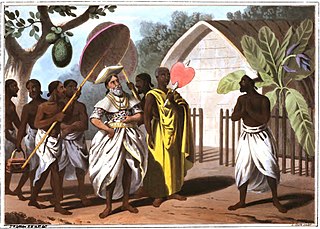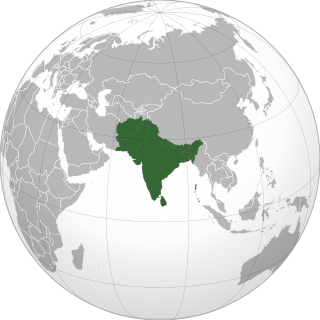Related Research Articles
The SiamNikaya is a monastic order within Sri Lankan Buddhism, founded by Upali Thera and located predominantly around the city of Kandy. It is so named because it originated within Thailand. The Siyam Nikaya has two major divisions and five other divisions within these two major units. The Malwatta and Asgiriya chapters have two separate Maha Nayakas or chief Monks.
The 'caste systems in Sri Lanka are social stratification systems found among the ethnic groups of the island since ancient times. The models are similar to those found in Continental India, but are less extensive and important for various reasons, although the caste systems still play an important and at least symbolic role in religion and politics. Sri Lanka is often considered to be a casteless or caste-blind society by Indians.

Salagama is a Sinhalese caste found mostly in the southern coastal areas of Sri Lanka. The community was traditionally associated with the cultivation and management of cinnamon and were formerly also involved as weavers and soldiers.

The Jaffna Kingdom, also known as Kingdom of Aryachakravarti, of modern northern Sri Lanka was a historic monarchy that came into existence around the town of Jaffna on the Jaffna peninsula. It was traditionally thought to be established after the invasion of Magha, who is credited with the founding of the Jaffna kingdom and is said to have been from Kalinga, in India. Established as a powerful force in the north, north east and west of the island, it eventually became a tribute-paying feudatory of the Pandyan Empire in modern South India in 1258, gaining independence in 1323, when the last Pandyan ruler of Madurai was defeated and expelled in 1323 by Malik Kafur, the army general of the Delhi Sultanate. For a brief period, in the early to mid-14th century, it was an ascendant power in the island of Sri Lanka when all regional kingdoms accepted subordination. However, the kingdom was eventually overpowered by the rival Kotte Kingdom, around 1450 when it was invaded by Prince Sapumal under the orders of Parakramabahu VI.
Koviyar is a Tamil caste found in Sri Lanka. They are traditional agriculturalists and temple workers. Kattavarayan as caste deity is observed by the Koviar.
Demalagattara are a social group or caste amongst the Sinhalese of Sri Lanka. Demalagattara are Theravada Buddhists by religion. They are ethnically Sinhalese but proclaim their Tamil ethnic origins, whereas all other South India-derived castes such as Karave, Salagama, Durave and Berava do not emphasise their Tamil links as part of their assimilation into Sinhalese society.
Durave or Durava or Durawa are a southern coastal Sinhalese caste in Sri Lanka. Their traditional occupation is toddy tapping. They trace their ancestry to medieval period migrants from South India. The term Durave arise from Tamil word Duraivan (துறைவன்) means person belongs to port region. The caste of Duraivan still exist in the district of Kanyakumari in Tamil Nadu where they indulge in fishing, toddy taping and trade.
Govigama is a Sinhalese caste found in Sri Lanka. They form approximately half of the Sinhalesee population and are traditionally involved in agriculture. The term Govigama became popular during the last period of the Sinhalese Kingdom of Kandy. Its members have dominated and influenced national politics and Sinhalese Buddhism.

Radala refers to a small minority group in Sri Lanka in the former provinces of the Kingdom of Kandy, who are either descendants of chiefs and courtiers of the King of Kandy or descendants of native headmen appointed by the British colonial administration following the Uva Rebellion in 1818.

Mudali was a colonial title and office in Ceylon which was part of the native headman system. The Portuguese colonials created the Mudaliyar class in the 17th century by enlisting natives of different castes from the coastal areas.
This was researched by Banu Mallesh Chintakindi from Raipole. "Rajas" means dirt in Sinhala and Pali or Sanskrit, and "Rajaka" means the removers of dirt. They collected cloths by traveling home to home of higher castes but now that was obsolete in India states like Telangana and Andhra Pradesh, but they still perform several rituals in weddings and several festivals done in villages or their surrounding areas. In this community they are called chakali or Rajaka, meant to show pride for their caste. Many are agriculture cultivators and farmers.There are many freedom fighters from this community and the brave women chakali Ilamma who fought for the people.
Bathgama a Sri Lankan caste predominantly in the Kandyan provinces, the traditional occupation of which was the cultivation of rice paddy. Hence the name Bath (rice) and Gama (village) in the Sinhala language.
The Pamunu people were tenant farmers of rice paddies in Sri Lanka's history. They are sometimes referred to as a sub-caste of the Govigama caste.
The Porowakara were a minority community of wood cutters from Sri Lanka. They were a part of the feudal land tenure system of Sri Lanka but eventually became absorbed into larger communities.
Vanniar or Vanniyar was a title borne by chiefs in medieval Sri Lanka who ruled in the Chiefdom of Vavuni regions as tribute payers to the Jaffna vassal state. There are a number of origin theories for the feudal chiefs, coming from an indigenous formation. The most famous of the Vavni chieftains was Pandara Vannian, known for his resistance against the British colonial power.

The Vanni chieftaincies or Vanni principalities was a region between Anuradhapura and Jaffna, but also extending to along the eastern coast to Panama and Yala, during the Transitional and Kandyan periods of Sri Lanka. The heavily forested land was a collection of chieftaincies of principalities that were a collective buffer zone between the Jaffna Kingdom, in the north of Sri Lanka, and the Sinhalese kingdoms in the south. Traditionally the forest regions were ruled by Vedda rulers. Later on, the emergence of these chieftaincies were a direct result of the breakdown of central authority and the collapse of the Kingdom of Polonnaruwa in the 13th century, as well as the establishment of the Jaffna Kingdom in the Jaffna Peninsula. Control of this area was taken over by dispossessed Sinhalese nobles and chiefs of the South Indian military of Māgha of Kalinga (1215–1236), whose 1215 invasion of Polonnaruwa led to the kingdom's downfall. Sinhalese chieftaincies would lay on the northern border of the Sinhalese kingdom while the Tamil chieftaincies would border the Jaffna Kingdom and the remoter areas of the eastern coast, north western coast outside of the control of either kingdom.
Social class in Sri Lanka is often described as casteless, though caste is still found on the island in both a symbolic and a practical sense. Caste is also used in an analogous sense to refer to the new social class divisions that have appeared in recent decades. The combination of ethnic nationalist movements that saw caste as an island-wide dividing tool, strong emphasis on providing access to education and healthcare regardless of background, and historic lack of discrimination among the colonial civil service played a factor in eradicating the caste system in most sectors of the island's society. Although the Buddhist culture actively fought against all forms of class discrimination, many Buddhist organizations used caste as a method to extract surplus from temple property.

Charles Edgar Corea was a politician and a prominent freedom fighter of Sri Lanka.

Appuhamy or Appuhami from Appoe (Gentleman) and Hamie (Lord)(Hamie is a derivation of Sanskrit word Swami) is a Sinhala surname or an honorific term for men used traditionally between 14th and 20th centuries in Sri Lanka (Ceylon). It is also a term used for Dugaganna Rala of Kandyan era kings.

Dewa people were one of the four main tribes of ancient Sri Lanka who founded the coalition of Sinhalese nationality. Sinhalese people, are an Asura ethnic group of the island of Sri Lanka. They were historically known as Hela people, Ceylonese islanders, and Sinhalese islanders. They constitute about 75% of the Sri Lankan population and number greater than 16.2 million. The Sinhalese identity is based on language, cultural heritage and nationality. The Sinhalese people speak Sinhala, an insular Indo-Aryan language, and are predominantly Theravada Buddhists, although a minority of Sinhalese follow branches of Christianity and other religions.
References
- Ryan Bryce 1953 Caste in Modern Ceylon, Rutgers University Press
- Ceylon Gazetteer 1855